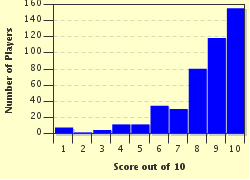Quiz Answer Key and Fun Facts
1. Pun Sill
2. Stale As (The ancient Sumerians used this one)
3. He Raise Sir
4. Shop Hen Err
5. Bloat Tank Pie Purr
6. Tap Right Err
7. Aisle Eye Tar
8. Pep Pie Razz (Another very ancient culture used this)
9. Core Wreck Shone Flew Hid
10. Hun Spy Ray Shun
Source: Author
Creedy
This quiz was reviewed by FunTrivia editor
spanishliz before going online.
Any errors found in FunTrivia content are routinely corrected through our feedback system.


